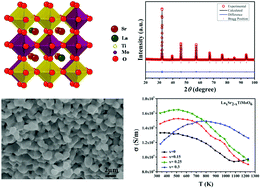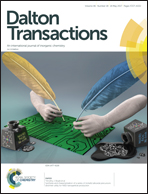Metal-like electrical conductivity in LaxSr2−xTiMoO6 oxides for high temperature thermoelectric power generation†
Abstract
Increasing electrical conductivity in oxides, which are inherently insulators, can be a potential route in developing oxide-based thermoelectric power generators with higher energy conversion efficiency. In the present work, environmentally friendly non-toxic double perovskite LaxSr2−xTiMoO6 (LSTM) ceramics were synthesized using a solid-state reaction route by optimizing the sintering temperature and atmosphere for high temperature thermoelectric applications. Rietveld refinement of XRD data confirmed a single-phase solid solution with a cubic structure in these double perovskites with the space-group Pm![[3 with combining macron]](https://www.rsc.org/images/entities/char_0033_0304.gif) m. SEM studies showed a highly dense microstructure in these ceramics. High electrical conductivity on the order of 105 S m−1 and large carrier concentration (∼1022 cm−3) were obtained in these materials. The temperature-dependent electrical conductivity measurement showed that the LSTM ceramics exhibit a semiconductor to metal transition. Thermopower (S) measurements demonstrated the conductivity switching from a p-type to n-type behavior at higher temperature. A temperature dependent Seebeck coefficient was further explained using a model for coexistence of both types of charge carriers in these oxides. A conductivity mechanism of these double perovskites was found to be governed by a small polaron hopping model.
m. SEM studies showed a highly dense microstructure in these ceramics. High electrical conductivity on the order of 105 S m−1 and large carrier concentration (∼1022 cm−3) were obtained in these materials. The temperature-dependent electrical conductivity measurement showed that the LSTM ceramics exhibit a semiconductor to metal transition. Thermopower (S) measurements demonstrated the conductivity switching from a p-type to n-type behavior at higher temperature. A temperature dependent Seebeck coefficient was further explained using a model for coexistence of both types of charge carriers in these oxides. A conductivity mechanism of these double perovskites was found to be governed by a small polaron hopping model.



 Please wait while we load your content...
Please wait while we load your content...